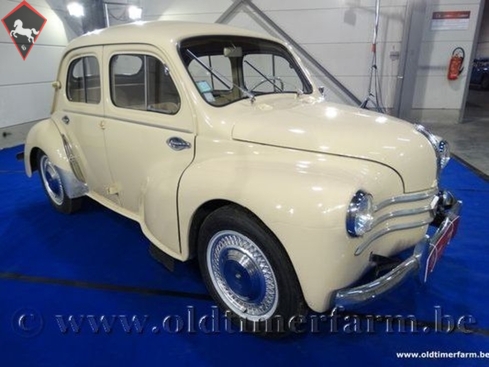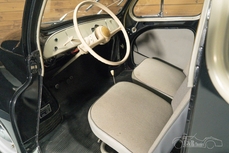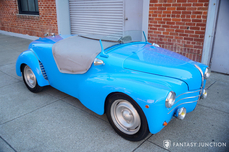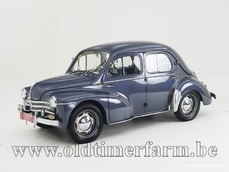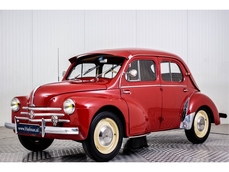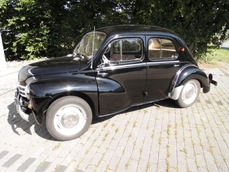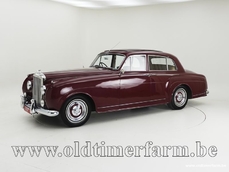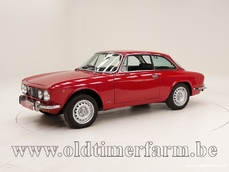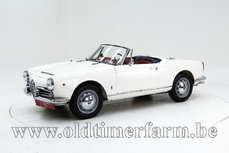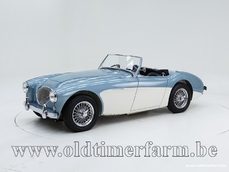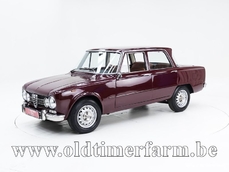Renault 4CV Beige '58 1958
General description :
(from Wikipedia, the free encyclopedia) The Renault 4CV (French pronunciation CAT shuVOH) is an economy car produced by the French manufacturer Renault from August 1947-July 1961. The first French car to sell over a million units, the 4CV was superseded by the Dauphine. The 4CV was a four-door sedan of monocoque construction, 3.6 m (11 ft 10 in) in length with front suicide doors[3] and using Renault's Ventoux engine in a rear-engine, rear-wheel drive layout. The car's name, 4CV, refers to the French abbreviation, CV, for the French equivalent to "horsepower" as a unit of power, translating from cheval vapeur." At the time, a vehicle's horsepower was used as its tax classification, which in the case of the 4CV was four taxable horsepower. In 1996, Renault presented a concept car the Renault Fiftie to celebrate the 50th anniversary of the 4CV's debut. It was a two-door, mid-engine design with styling similar to the 4CV. The 4CV was originally conceived and designed covertly by Renault engineers during the World War II German occupation of France, when the manufacturer was under strict orders to design and produce only commercial and military vehicles. Between 1941 and 1944 Renault was placed under the Technical Directorship of a francophile engineer called Wilhelm von Urach (between 1927 and 1940 employed by Daimler Benz) who took care to notice nothing of the small car project. A design team led by the company's Technical Director Fernand Picard, recently returned from Renault's aero-engine division to the auto business and Charles-Edmond Serre, who had been with Renault for longer than virtually anyone else envisioned a small, economical car suitable for the period of austerity which was expected to follow the war. This was in contrast to Louis Renault himself who in 1940 believed that after the war Renault would need to concentrate on its traditional mid-range cars. Jean-Auguste Riolfo, head of the test department, was made aware of the project from an early stage as were several other heads of department. In May 1941 Louis Renault himself burst into an office to find Serre and Picard studying a mock-up for the car's engine. By the end of an uncomfortable ad hoc meeting Renault's approval for the project, now accorded the code "106E", was provided. However, because the Germans had forbidden work on any new passenger car models, the 4CV development was defined, if at all, as a low priority spin-off from a project to develop a new engine for a post-war return of the company's 1930s small car, the Juvaquatre: departmental bosses installed by the Germans were definitely not to be trusted in respect of "Project 106E", while von Urach, their overlord, always managed to turn a blind eye to the whole business. The 4CV was ultimately presented to the public and media at the 1946 Paris Motor Show and went on sale a year later. Volume production was said to have commenced at the company's Billancourt plant a few weeks before the Paris Motor Show of October 1947, although the cars were in very short supply for the next year or so. Renault's advertising highlighted the hundreds of machine-tools installed and processes adopted for the assembly of the first high volume car to be produced since the war, boasting that the little car was now no longer a prototype but a reality. On the 4CV's launch, it was nicknamed "La motte de beurre" (the lump of butter); this was due to the combination of its shape and the fact that early deliveries all used surplus paint from the German Army vehicles of Rommel's Afrika Korps, which were a sand-yellow color. Later it was known affectionately as the "quatre pattes", "four paws".The 4CV was initially powered by a 760 cc rear-mounted four-cylinder engine coupled to a three-speed manual transmission. In 1950, the 760 cc unit was replaced by a 747 cc version of the "Ventoux" engine producing 17 hp (13 kW). Despite an initial period of uncertainty and poor sales due to the ravaged state of the French economy, the 4CV had sold 37,000 units by mid-1949 and was the most popular car in France. The car remained in production for more than another decade. Claimed power output increased subsequently to 21 hp (16 kW) as increased fuel octanes allowed for higher compression ratios, which along with the relatively low weight of the car (620 kg (1,400 lb)) enabled the manufacturers to report an 090 km/h (056 mph) time of 38 seconds and a top speed barely under 100 km/h (62 mph). The engine was notable also for its elasticity, the second and top gear both being usable for speeds between 5 and 100 km/h (3 and 62 mph); the absence of synchromesh on first gear would presumably have discouraged use of the bottom gear except when starting from rest. The 4CV's direct replacement was the Dauphine, launched in 1956, but the 4CV in fact remained in production until 1961. The 4CV was replaced by the Renault 4 which used the same engine as the 4CV and sold for a similar price. Specifications. Bodywork. Length/width/height/wheelbase cm (in) : 360/143/147/209 (142/56.3/57.9/82.5); weight : 560 kg (1235 lb). Mechanics. Engine straight-four 747 cc (45.5 ci), rear-mounted, 8 valves, 1 Solex carburettor, manual 3 speed gearbox, rear-wheel drive. Maximum power : 21 bhp at 4100 rpm; torque : 45 Nm at 2000 rpm. Top speed : 100 km/h (62 mph). This car is just in at Oldtimerfarm, Aalter Belgium. Steenweg op Deinze 51C. Teusday-Saterday 10-17h (no appointment needed) Sunday: closed. Monday strictly on appointment. We specialize in consignment sales of collection cars. We are proud we can offer this car for sale. A more detailed description will soon follow. In the meantime you can have a look at the very ample photo coverage on the website. Of course Xavier or Olivier will be very happy to give you all possible explanations by phone on +32472401338. Meet us at: Opendeurdagen Fri, September 18, 2015, 9am – Sun, September 20, 2015, 5pm
http://www.oldtimerfarm.be/en/collection-cars-for-sale/2151/renault-4cv-beige-58.php
1958 Renault 4CV Beige '58 is listed sold on ClassicDigest in Aalter by Oldtimerfarm Dealer for €7500.
Car Facts
Car type : Car Make : Renault Model : 4CV Model Version : Beige '58 Engine size : 0.0 Model Year : 1958 Location : Aalter Vehicle Registration : Normal
Sold
Seller Information
Sold
People who viewed this Renault 4CV also viewed similar Renault listed at ClassicDigest
Other cars listed for sale by this dealer
About Renault
Ah, Renault, a name that's as French as a croissant and as ingrained in automotive history as a baguette in a Parisian café. Let's take a leisurely drive through the annals of this storied manufacturer, shall we?Our story begins in the late 19th century when the Renault brothers, Louis, Marcel, and Fernand, decided to put their inventive minds to work. In 1898, they introduced their very first car, the Renault Voiturette. It was a petite, rear-engined contraption that looked like something Jules Verne might have designed. This pint-sized pioneer laid the foundation for Renault's automotive legacy.
Now, if we're talking about influential Renault models, we mustn't overlook the Renault 4. Launched in 1961, it was the French answer to the Volkswagen Beetle. The Renault 4 was practical, versatile, and designed to handle the rough and tumble of rural France. It was as much at home in the city as it was on a farm, a true embodiment of French pragmatism.
But let's not forget the Renault 5, or "Le Supercinq" as it was known in France. Introduced in the mid-'70s, this little hatchback was a design sensation. Its quirky, angular lines and cheeky personality made it an instant hit. It was economical, fun to drive, and became an icon of French urban life.
Then came the Renault Espace in 1984. It was one of the pioneers of the MPV (multi-purpose vehicle) segment. The Espace was designed for families who wanted the practicality of a van without sacrificing the comfort of a car. It was the beginning of a new era in family transport.
And let's not forget the Renault Twingo, introduced in 1992. It was a small city car that broke the mold with its innovative design and rear-engine layout. The Twingo was proof that small cars could be stylish and practical, and it was a hit with urban dwellers across Europe.
Now, if you want to talk about a true game-changer, it's the Renault Clio. First introduced in 1990, the Clio became a European favorite. It combined style, performance, and affordability in a way that few cars could match. It's the kind of car that's as comfortable on the Champs-Élysées as it is navigating the narrow streets of a French village.
But, of course, we can't forget the Renault Megane. It's been a stalwart of the compact car segment since its debut in 1995. With its distinctive rear-end design and a range of engines to suit every taste, the Megane has remained a strong contender in a competitive market.
So there you have it, a leisurely tour through the history of Renault, a company that has always managed to infuse a touch of French flair into the automotive world. Renault has given us cars that are as diverse as the French countryside itself, from practical workhorses to stylish city slickers. It's a brand that's as much a part of France's cultural tapestry as a bottle of Bordeaux or a game of pétanque. Vive la Renault!
